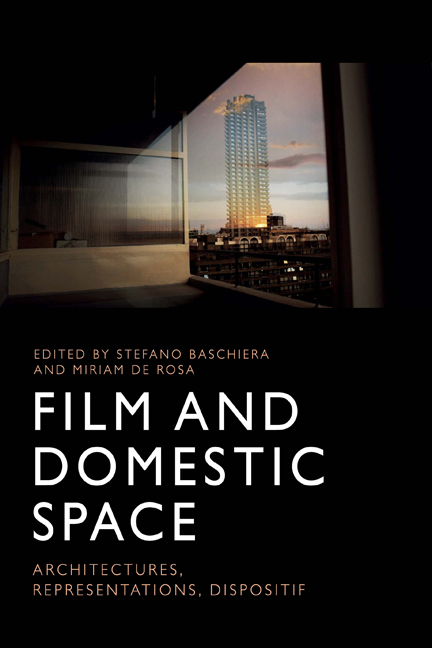Book contents
- Frontmatter
- Contents
- List of Figures
- Notes on the Contributors
- Acknowledgements
- Introduction
- 1 Architectures of Ubiquity: The Colonial Revival in Film and Television
- 2 No Down Payment: Whiteness, Japanese American Masculinity and Architectural Space in the Cinematic Suburbs
- 3 Resist, Redefine, Appropriate: Negotiating the Domestic Space in Contemporary Female Biopics
- 4 Liminal Spaces, Lesbian Desire and Veering off Course in Todd Haynes’s Carol
- 5 A Home on the Road in Claire Denis’s Vendredi soir
- 6 Acoustic Ectoplasm and the Loss of Home
- 7 Our House Now: Flat and Reversible Home Spaces in Post-war Film and Television
- 8 From Myth to Reality: Images of Domestic Space in Post-Soviet Baltic Films
- 9 No | Home | Movie: Essay Film, Architecture as Framing and the Non-house
- 10 At Home with the Nouvelle Vague: Apartment Plots and Domestic Urbanism in Godard’s Une femme est une femme and Varda’s Cléo de 5 à 7
- 11 Dwelling the Open: Amos Gitai and the Home of Cinema
- 12 What Is Cult When It’s At Home? Reframing Cult Cinema in Relation to Domestic Space
- 13 High-fructose Cinema and the Movie Industrial Complex: Radicalising the Technology of Representation in a Domestic Kind of Way
- Index
10 - At Home with the Nouvelle Vague: Apartment Plots and Domestic Urbanism in Godard’s Une femme est une femme and Varda’s Cléo de 5 à 7
Published online by Cambridge University Press: 22 September 2020
- Frontmatter
- Contents
- List of Figures
- Notes on the Contributors
- Acknowledgements
- Introduction
- 1 Architectures of Ubiquity: The Colonial Revival in Film and Television
- 2 No Down Payment: Whiteness, Japanese American Masculinity and Architectural Space in the Cinematic Suburbs
- 3 Resist, Redefine, Appropriate: Negotiating the Domestic Space in Contemporary Female Biopics
- 4 Liminal Spaces, Lesbian Desire and Veering off Course in Todd Haynes’s Carol
- 5 A Home on the Road in Claire Denis’s Vendredi soir
- 6 Acoustic Ectoplasm and the Loss of Home
- 7 Our House Now: Flat and Reversible Home Spaces in Post-war Film and Television
- 8 From Myth to Reality: Images of Domestic Space in Post-Soviet Baltic Films
- 9 No | Home | Movie: Essay Film, Architecture as Framing and the Non-house
- 10 At Home with the Nouvelle Vague: Apartment Plots and Domestic Urbanism in Godard’s Une femme est une femme and Varda’s Cléo de 5 à 7
- 11 Dwelling the Open: Amos Gitai and the Home of Cinema
- 12 What Is Cult When It’s At Home? Reframing Cult Cinema in Relation to Domestic Space
- 13 High-fructose Cinema and the Movie Industrial Complex: Radicalising the Technology of Representation in a Domestic Kind of Way
- Index
Summary
In their groundbreaking move from the studio to the streets, embracing the idea of a ‘camera-pen’ (Astruc 1999) to tell personal stories and offer a personalised portray of urban geography, the directors of the French new wave not only challenged the established mode of production and the tradition of the cinéma de papa but also revealed new connections between characters, spaces and the camera itself. As James Tweedie (2013), among others, argues, it is in the attention given to the objects and spaces present in front of the camera, rather than the filmic style, that the innovative contribution of the nouvelle vague manifests itself. In particular, the representation of social space is considered one of the key features in the films of the young filmmakers, to the extent that it can be argued that the Lefebvrian ‘urban revolution’ found its manifestation in the early films of the nouvelle vague. The works of Louis Malle, Jacques Rivette, Eric Rohmer, Jean-Luc Godard, François Truffaut and Agnès Varda mapped the transformations, paradoxes, uncertainties and possibilities present in the ‘critical phase’ of the passage from an industrial to an urban society (see Lefebvre 2003). During this phase, the street acquired a double value: on the one hand, it became a meeting place, the crucial space of movement. On the other hand, the street gave rise to superficial interactions dictated by the commodification of the space. Since ‘the street became a network organized for and by consumption’ (Lefebvre 2003: 20), time changed as a function of the need to gaze at shop windows and to consume, or according to the modes of transportation associated with the street. The street, during this critical phase, is the demonstration of the power of the neocapitalistic organisation of consumption, and ‘in this sense we can speak of a colonization of the urban space, which takes place in the street through the image, through publicity, through the spectacle of objects – a “system of objects” that has become symbol and spectacle’ (Lefebvre 2003: 21). From this perspective, the constant interaction between fictional characters and real spaces present in early nouvelle vague films can be considered as part of this colonisation of urban space by the spectacle.
- Type
- Chapter
- Information
- Film and Domestic SpaceArchitectures, Representations, Dispositif, pp. 171 - 187Publisher: Edinburgh University PressPrint publication year: 2020



